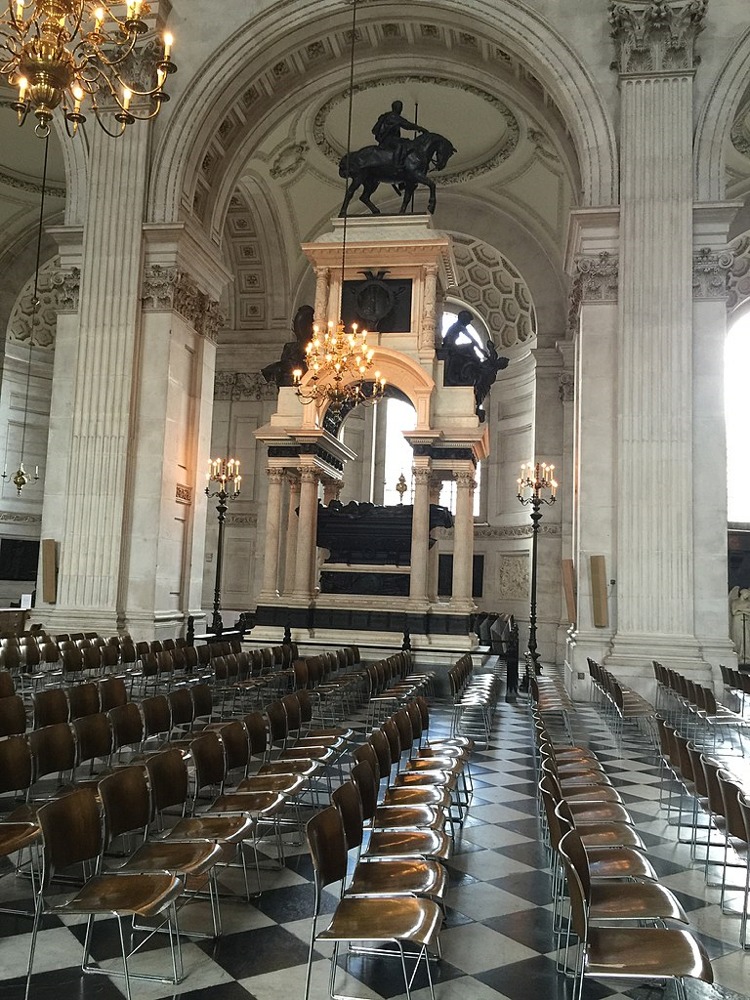Arthur Wellesley Memorial
Home > Photos from England > St. Pauls Cathedral > 1st Duke of Wellington's Memorial

Arthur Wellesley, 1st Duke of Wellington's memorial at St Paul's Cathedral's in London, England.
This photograph is licensed under the Creative Commons Attribution-Share Alike 2.0 license. Author: Katie Chan. It has been modified to have a horizontal pixel count of 1000.
Arthur Wellesley, 1st Duke of Wellington
Arthur Wellesley, 1st Duke of Wellington, KG, GCB, GCH, PC, FRS (1 May 1769 – 14 September 1852) was an Anglo-Irish soldier and Tory statesman who was one of the leading military and political figures of 19th-century Britain, serving twice as prime minister of the United Kingdom. He is among the commanders who won and ended the Napoleonic Wars when the Seventh Coalition defeated Napoleon at the Battle of Waterloo in 1815.
Wellesley was born in Dublin into the Protestant Ascendancy in Ireland. He was commissioned as an ensign in the British Army in 1787, serving in Ireland as aide-de-camp to two successive lords lieutenant of Ireland. He was also elected as a member of Parliament in the Irish House of Commons. He was a colonel by 1796 and saw action in the Netherlands and in India, where he fought in the Fourth Anglo-Mysore War at the Battle of Seringapatam. He was appointed governor of Seringapatam and Mysore in 1799 and, as a newly appointed major-general, won a decisive victory over the Maratha Confederacy at the Battle of Assaye in 1803.
Wellesley rose to prominence as a general during the Peninsular campaign of the Napoleonic Wars, and was promoted to the rank of field marshal after leading the allied forces to victory against the French Empire at the Battle of Vitoria in 1813. Following Napoleon's exile in 1814, he served as the ambassador to France and was granted a dukedom. During the Hundred Days in 1815, he commanded the allied army which, together with a Prussian Army under Field Marshal Gebhard von Blücher, defeated Napoleon at Waterloo. Wellington's battle record is exemplary; he ultimately participated in some 60 battles during the course of his military career.
Wellington is famous for his adaptive defensive style of warfare, resulting in several victories against numerically superior forces while minimising his own losses. He is regarded as one of the greatest defensive commanders of all time, and many of his tactics and battle plans are still studied in military academies around the world. After the end of his active military career, he returned to politics. He was twice British prime minister as a member of the Tory party from 1828 to 1830 and for a little less than a month in 1834. He oversaw the passage of the Roman Catholic Relief Act 1829, but opposed the Reform Act 1832. He continued as one of the leading figures in the House of Lords until his retirement and remained Commander-in-Chief of the British Army until his death.
St Paul's Cathedral
St Paul's Cathedral is an Anglican cathedral in London and is the seat of the Bishop of London. The cathedral serves as the mother church of the Diocese of London. It is on Ludgate Hill at the highest point of the City of London and is a Grade I listed building. Its dedication to Paul the Apostle dates back to the original church on this site, founded in AD 604. The present structure, dating from the late 17th century, was designed in the English Baroque style by Sir Christopher Wren. Its construction, completed in Wren's lifetime, was part of a major rebuilding programme in the city after the Great Fire of London. The earlier Gothic cathedral (Old St Paul's Cathedral), largely destroyed in the Great Fire, was a central focus for medieval and early modern London, including Paul's walk and St Paul's Churchyard, being the site of St. Paul's Cross.
The cathedral is one of the most famous and recognisable sights in London. Its dome, surrounded by the spires of Wren's City churches, has dominated the skyline for over 300 years. At 365 ft (111 m) high, it was the tallest building in London from 1710 to 1963. The dome is still one of the highest in the world. St Paul's is the second-largest church building in area in the United Kingdom, after Liverpool Cathedral.
Services held at St Paul's have included the funerals of Admiral Lord Nelson, the Duke of Wellington, Winston Churchill, and Margaret Thatcher; jubilee celebrations for Queen Victoria; an inauguration service for the Metropolitan Hospital Sunday Fund; peace services marking the end of the First and Second World Wars; the wedding of Prince Charles and Lady Diana Spencer; the launch of the Festival of Britain; and the thanksgiving services for the Silver, Golden, Diamond, and Platinum Jubilees and the 80th and 90th birthdays of Queen Elizabeth II. St Paul's Cathedral is the central subject of much promotional material and images of the dome surrounded by the smoke and fire of the Blitz. The cathedral is a working church with hourly prayer and daily services. The tourist entry fee at the door is £21 for adults (Summer 2022, cheaper if booked online), but no charges are made to worshippers attending advertised services.
The nearest underground station is St Paul's, which is 130 yards (120 m) away from St Paul's Cathedral.
From Wikipedia, the free encyclopedia.


